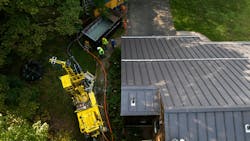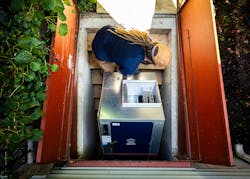How Geothermal Can Change Multifamily Construction
By WYATT ROBERTS, Dandelion Energy
The U.S. has a significant housing problem.
More specifically, there are too few housing options for too many buyers. In the multifamily space, there are too few apartments for the number of renters. It’s a supply and demand issue prompting state and local governments to invest in multifamily housing that’s both sustainable and capable of meeting the growing demand for affordable living spaces.
Multifamily housing, which incorporates a wide range of residential buildings and complexes containing multiple separate housing units within a single structure, isn’t just an opportunity to create more housing. It’s also a golden opportunity to develop a generation of housing that’s more energy-efficient, environmentally friendly, and cost-effective.
After all, the housing sector isn’t just a minor contributor to climate change. The United Nations notes that housing accounts for 37% of total emissions, making it one of the most prominent building types to influence climate outcomes.
Traditional HVAC systems are the leading contributor to climate change, collectively emitting more than 441 million tons of carbon dioxide into the atmosphere annually. With many reliant on fossil fuels, propane, heating oil, or less-efficient electrified equipment, these outdated systems create comfortable indoor settings... but make the planet increasingly hotter and less habitable.
Geothermal heating and cooling systems offer a realistic alternative for new multifamily construction.
Explaining Geothermal Heating & Cooling
Geothermal heating and cooling systems take advantage of the consistent air temperature just a few feet below the surface to transfer heat between the building and the earth.
These systems have three major components.
- First, ground loops below the building are filled with water and, in cold climates, earth-friendly antifreeze. In the summer, the circulating fluid transfers heat out of the house; in the winter, it pulls heat from the ground into the building. In other words, a great heat source and a great heat sink sit below every building;
- Then heat pumps inside the building, which typically replace a traditional HVAC system, draw warm air from the house in the summer and move warm air in during the winter;
- Finally, a geothermal heating and cooling system uses ductwork to circulate air throughout the building.
These systems work with conventional ductwork like most conventional systems.
Notably, geothermal heating and cooling systems are electric-powered, liberating building owners and their tenants from fossil fuel, heating oil, and natural gas. They are a 2-in-1 climate control system that lowers costs, reduces carbon emissions, and provides year-round comfort.
According to the US Environmental Protection Agency (EPA), “Geothermal heat pumps are the most energy-efficient, environmentally clean, and cost-effective systems for heating and cooling buildings.”
While retrofitting existing buildings is possible, leveraging geothermal heating and cooling for new construction is even easier, as developers can integrate the system from the ground up, optimizing building design and maximizing energy efficiency from day one.
Why Developers Should Choose Geothermal
There are several reasons that developers should make geothermal heating and cooling a priority when building new multifamily residences:
#1 Financial Incentives
Tax credits apply to the building owner, so the economics are tremendous. For example, tax rebates and incentives combined offset up to 70% of the initial cost of installing a geothermal heating and cooling system when building new multifamily housing. When coupled with Energy Star and ZERH incentives, the cost of installing a geothermal heating and cooling system becomes even more cost-effective and financially advantageous, including:
● Thirty percent Federal Tax Credit + 10 percent domestic tax credit;
● Kicker+10 percent Energy Community;
● Energy Star 3.2 45L and DOE ZERH 45L;
● 168E, 5-yr depreciation;
● Local and state level incentives that may be available;
● Potential for additional funding around LMI aspects of the project.
Taken together, the financial incentives mean there has never been a more affordable time to install geothermal heating and cooling in new multifamily units
#2 Cost Savings
In one multifamily unit, geothermal heating and cooling units were 36% more efficient than air-source heat pumps (ASHPs) and significantly more efficient than traditional HVAC units, saving $400 per apartment unit in first-year operating costs.
When multifamily buildings have hundreds of units, these cost savings are substantial, potentially amounting to hundreds of thousands of dollars annually for the entire property.
#3 Product Durability
Traditional HVAC units must be replaced every 10 to 15 years. But geothermal heating and cooling systems last longer, allowing owners to minimize maintenance and replacement costs.
Geothermal heat pumps last up to twice as long as ASHPs and conventional fuel-fired equipment, with lower maintenance due to the absence of outdoor mechanicals exposed to the elements and the elimination of combustion. Geothermal ground loops last the life of the building and never need to be replaced.
Overall, geothermal heating and cooling also is significantly cheaper to maintain than traditional HVAC units. This translates to lower maintenance costs, fewer service interruptions, and better profit margins that can make properties more financially feasible to manage.
#4 Spatial Preferences
In multifamily housing units, traditional HVAC units are often installed on rooftops or in amenity spaces.
With geothermal heating and cooling, owners can reclaim these spaces. For instance, instead of installing a condenser unit on the roof, owners can instead install a pool or terrace, driving up property values and increasing tenant satisfaction.
Owners could also use this space to install solar panels, further driving down energy costs and making their properties more energy-efficient and sustainable.
#5 Regulatory Requirements
New regulations are raising the cost of traditional HVAC in multifamily housing, and developers must meet new energy efficiency requirements.
As an all-electric, highly efficient climate control solution, geothermal heating and cooling solves both problems. Some developers opt for air-source heat pumps, which have the same energy rating as fossil fuels, making them less helpful when meeting regulatory requirements.
In contrast, geothermal heating and cooling is the best-in-class solution for reaching measurable carbon offset goals.
Each of these benefits offer a compelling reason to switch to geothermal heating and cooling. Taken together, it’s clear that geothermal at the foundation level is a must for multifamily developers in 2025 and beyond.
Best Practices For Planning Geothermal
Geothermal heating and cooling is an investment in long-term energy efficiency and environmental sustainability that, with the right planning and procedures, can make multifamily housing better for owners, renters, and communities.
To make the installation process a success, developers and their engineering and construction partners should prioritize:
● Early Planning: Consider geothermal well before starting construction. Design and installation of the ground loop should be one of the first items on the schedule;
● Foundation-Level Installation: When space is a constraint, plan to install the ground loop under the building or parking structure during initial construction;
● Consider Building Type: Adapt the geothermal approach based on whether it's a low-rise, mid-rise, or high-rise building;
● Integrate with Building Design: Consider how geothermal systems can free up rooftop space for amenities or solar panels, as there's no need for rooftop compressors;
● Leverage Financial Incentives: Take advantage of tax credits and accelerated depreciation benefits available under the Inflation Reduction Act as well as local and state-level incentives.
Geothermal heating and cooling doesn’t have to complicate the building process. In fact, with the right processes and practices, it can be a seamless transition from HVAC technology to geothermal heating and cooling solutions.
Transforming Multifamily Housing
Developers are facing a new era where building in a new way is the way forward to future-proof against volatile energy pricing, fluctuating regulations, and climate change.
Integrating geothermal technology from the ground up allows multifamily projects to address immediate housing needs and contribute to a more sustainable future.
That’s why right now is the right time for developers to future-proof their properties and unlock significant financial incentives with geothermal heating and cooling.
##########
Author Bio: Wyatt Roberts is Head of New Construction for Dandelion Energy. He is a builder and a building scientist, and is passionate about reducing the impact of our built world on the global environment. He is also a Certified Passive House Designer (CPHD). For more information, visit www.dandelionenergy.com.


